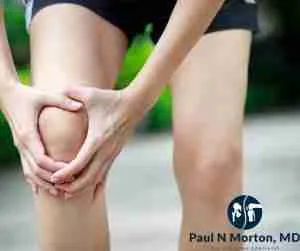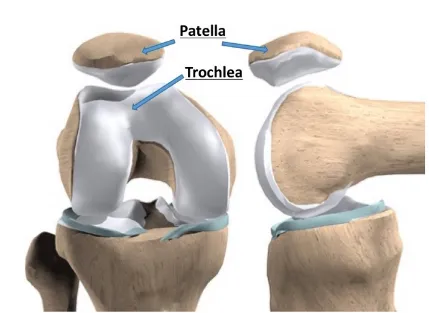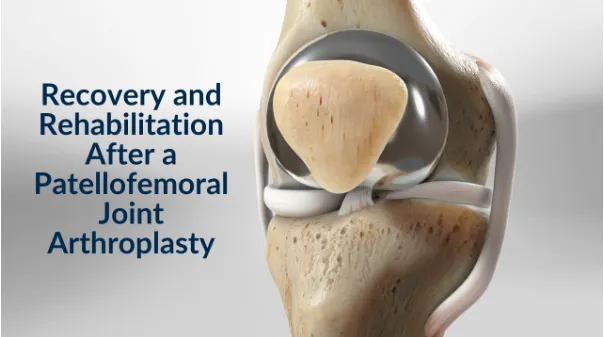
A Patellofemoral Joint Arthroplasty is a surgical procedure that involves removing the damaged cartilage from your knee to replace it with an artificial implant.
This surgery aims to restore normal alignment and movement in your knee, which can be impaired by arthritis or injury.
The best candidates for this procedure are those who have been diagnosed with degenerative patellar disease or osteoarthritis, as well as athletes who have suffered injuries to their patella (kneecap).
Symptoms of Patellofemoral Arthritis
Patellofemoral arthritis occurs when there’s significant wear-and-tear or damage to the cartilage under the kneecap (patella), resulting in pain and difficulty in movement. It’s a type of osteoarthritis, the most common form of arthritis.
The symptoms of patellofemoral arthritis can vary among individuals, but they typically include:
- Knee pain: This is the most common symptom, often described as a dull, aching pain. It may be experienced in the front of the knee, around the kneecap. The pain often worsens with activities that require bending of the knee, like walking, running, squatting, kneeling, or climbing stairs.
- Stiffness: The knee may feel stiff, especially after prolonged periods of sitting or inactivity, or when you first wake up in the morning.
- Crepitus: This refers to a crunching or grinding sensation when the knee is moved or flexed. It’s due to the roughened, damaged surfaces of the cartilage rubbing together.
- Swelling: Some people may notice swelling around the knee, especially after extended activity.
- Decreased range of motion: Over time, the knee may not fully extend or bend due to pain or stiffness.
- Weakness or instability: Some individuals may feel that their knee is giving way or unable to support their weight.
The Procedure of a Patellofemoral Joint Arthroplasty
The procedure of a Patellofemoral Joint Arthroplasty is performed under anesthesia.
An incision is made over the knee joint through which the damaged cartilage and bone surfaces are removed, including:
The underside of the patella (kneecap).
The anterior part of the femur (trochlear groove).
The surgeon then reshapes these areas, and artificial implants are inserted in their place, allowing the normal function of your knee again!

Recovery and Rehabilitation After a Patellofemoral Joint Arthroplasty
After the surgery, you will be placed in a soft dressing. You may also need crutches or a cane for support. Your doctor will tell you when it is safe for you to begin physical therapy exercises and return home from the hospital.
The main goal of rehabilitation after this procedure is to regain strength in your quadriceps muscles and improve the range of motion in your knee.
Patellofemoral arthroplasty is a surgical procedure that can be performed to treat knee pain caused by arthritis.
The surgery involves replacing the damaged cartilage in your patella (kneecap) with an artificial implant, which allows for improved mobility and reduced risk of injury.
Benefits of Patellofemoral Joint Arthroplasty:
- Pain relief – Replacing the damaged parts of the patellofemoral joint can significantly reduce pain.
- Improved mobility – One of the biggest benefits of patellofemoral joint replacement surgery is that it allows people who have trouble bending their knees due to arthritis or other conditions to regain their flexibility and mobility, enabling them to perform everyday activities without pain or discomfort.
Risks of Patellofemoral Joint Arthroplasty
Patellofemoral joint arthroplasty is a safe procedure with few risks. However, some complications can occur during or after surgery. The most common complications include the following:
- Infection
- Nerve Damage (paralysis)
- Blood Clots (deep vein thrombosis)
- Worsening arthritis to the other compartments
- Persistent pain
- Stiffness
Alternatives to Patellofemoral Joint Arthroplasty
If you’re not a candidate for surgery, there are still some options. Physical therapy can help to strengthen the muscles around your knee and improve flexibility.
Corticosteroid injections may also be used to reduce inflammation and pain in the joint.
These treatments are effective in some cases but may not provide long-term relief from symptoms if they don’t address the root cause of your patellofemoral arthritis.
Questions You Should Ask Before Undergoing a Patellofemoral Joint Arthroplasty
Before undergoing any surgery, it’s important to ask your doctor about the expected outcome of the procedure.
You should also ask about risks and complications that may occur during or after surgery.
Additionally, you should inquire about recovery time and how long you will need to stay in the hospital following your operation.
Tips for a Smooth Recovery After a Patellofemoral Joint Arthroplasty
Follow your doctor’s instructions. You’ll likely be given a list of recommendations for caring for yourself after surgery, including what you should eat, how much activity is appropriate, and when it’s okay to drive. Be sure to follow these guidelines closely to heal as quickly as possible and avoid complications.
Take your medications as prescribed. Your doctor will prescribe pain medication after surgery; be sure that you take it and don’t abuse it by taking more than recommended or combining it with alcohol or other drugs (which could lead to serious side effects).
Also, make sure not to stop taking any prescribed medications without first consulting with your physician–doing so could cause withdrawal symptoms such as nausea and vomiting if abruptly stopped after being taken regularly over several days or weeks.
Conclusion
Patellofemoral joint arthroplasties are an effective treatment option for knee pain. However, it is important to consider all options before making a decision.
Speak with your doctor for more information about this procedure and how it can help you manage your symptoms.



